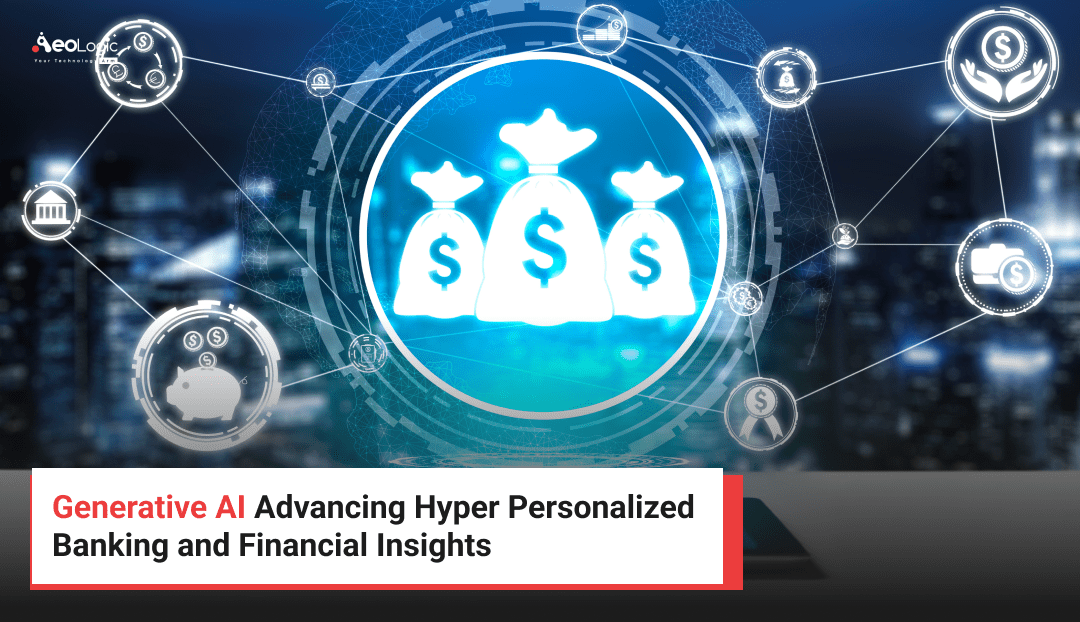Personalization has always been the most interesting, attractive, and modern thing in every industry, whether it is retail, financial, banking, business, or any other. The banking and financial industry has also been impacted by personalization, as they have the tools and technologies for various personalized experiences. However, with the world advancing and growing rapidly, they require more advanced personalization than conventional methods, including those in banking and finance.
Even with the conventional system, the financial insights also cannot be obtained in an advanced and accurate manner, which affects decision-making and other aspects. Where the conventional personalization affects customer services, decisions, inaccurate scenario analysis, and much more.
To enhance the personalization and financial insights advancement, generative AI-powered solutions are playing a great role. Generative AI can boost the hyper-personalization and advanced analytics systems that are more powerful than conventional ones.
The generative AI solutions are advancing the hyper-personalization of banking and financial insights with its advanced algorithm, content creation ability, potential to simulate market scenarios, defect and fraud prevention, capability to generate synthetic data, and much more.
Generative AI offers various applications and benefits too to enhance the hyper-personalization of banking and insights like tailored financial planning, AI assistants, better engagement ways, precision marketing, enhanced operational efficiency, and much more. Overall, the generative AI-powered hyper-personalization is going to evolve the whole banking and financial sector as never before.
Looking for? Top Generative AI Solutions Provider in India
Key Statistics
The global generative AI in banking and finance market size is worth around USD 1,260.16 million in 2024 and is anticipated to reach around USD 21,824.46 million by 2034, growing at a CAGR of 33% over the forecast period from 2024 to 2034.
Banks utilizing generative AI for credit risk assessment have achieved 48% more accurate risk predictions compared to traditional scoring models.
Accenture revealed that financial institutions implementing generative AI solutions have achieved an average 22% reduction in operational costs within the first 18 months of deployment.
Financial institutions that have deployed generative AI across customer touchpoints have witnessed an average 32% increase in customer satisfaction scores.
What Is Generative AI in Banking and How It Advance Hyper-Personalization for Financial Insights?
Generative AI in advancing hyper-personalization in the banking and financial industry refers to solutions that can enable personalization for various aspects like customer service, investment planning, personalized interface, personalized offers, and much more. Where the financial insights advancement with gen AI refers to the analysis of data to predict possible scenarios and possibilities to provide advanced insights that can enhance decision-making.
The hyper-personalization with gen AI differs from the conventional one as it involves all advanced aspects in comparison to the usual one, as it involves real-time data, advanced analytics, and generative AI models powered solutions.
Explore more: Benefits of Generative AI in Banking and Use Cases
Top Applications of Generative AI in Banking for Hyper-Personalized Financial Insights
There are various applications of generative AI for advancing hyper-personalized banking and financial insights. Here are the top applications mentioned below.
Tailored Investment and Financial Planning
The customers always want the best financial planning, and the banking organization also wants to offer the best plans. But the traditional system cannot conveniently help both sides. The generative AI-powered hyper-personalization solutions can analyze the customers’ needs, market demands, competitors’ conditions, factors that impact banking, and much more to offer the best financial planning in real time. This helps the customers to secure their future financially and also enables banking organizations to make a profit.
Virtual Financial Assistant
Assistance and guidance are very crucial in the financial and banking industry. But the banking organization cannot be available every time for the customers. Sometimes, the banking organizations also require some tips to manage their operations.
The traditional system cannot offer the assistance that can manage all the queries. The generative AI-powered hyper-personalized system can be used to develop advanced and intelligent AI assistants that can answer the queries of the customers with great personalization.
Dynamic and Visual Financial Reports
Data management, report generation, insights availability, etc, are the key aspects to make the right decision to make proper optimization of financial operations. But the traditional system is not capable of managing all. The generative AI-powered hyper-personalized system can develop solutions that convert raw data into personalized and visual reports, use different graph patterns to make an easy representation of data, generate synthetic data to complete the whole pattern, and much more. This helps the banking organization to make the right decision.
Personalized Fraud Alerts and Spending Insights
Fraud and theft are common issues in the banking industry nowadays that need to be solved to prevent any type of big loss. But the conventional system cannot detect the risk factors easily, as risk factors are also evolving day by day. Where the generative AI and hyper-personalization integration can develop specific and tailored solutions that can detect unusual patterns, unusual spending, unnecessary charges, and much more. This helps the banking industry to take preventive measures with time to stop any type of fraud.
Top Benefits of Generative AI in Banking for Hyper-Personalization
There are various benefits of generative AI for advancing hyper-personalized banking and financial insights. Here are a few mentioned below.
Deep Personalization
The traditional system can offer personalization at a certain limit that would not be enough for the future. Generative AI can boost hyper-personalization in the banking industry with advanced solutions. The customers can get a deep personalized experience on the financial planning, the banking organization can get personalized tips, better marketing, and service development on the basis of organizational conditions, etc.
Also Read: The Role of Automation in Banking Operations
Enhances Customer Engagement and Loyalty
Customers are the most important aspect for banking businesses. The traditional system cannot offer too much personalized experience, which results in dissatisfaction for the customers. Where the generative AI-powered hyper-personalized solutions, such as tailored services, interface, AI assistant, chatbots, marketing, guidance, and much more, are making a positive impact on the customer experience. This enhances customer engagement and loyalty towards the banking organization.
Also Read: Role of AI-Powered Chatbots On Customer Experience In Banks
Improved Financial Decision Making
Financial decision-making should be perfect to prevent any loss. But the conventional system generates tips and insights that may not work in every condition. The AI-powered personalization solutions can analyze the different data, factors, and scenarios for a specific banking organization, such as simulations, forecasts, and what-if scenarios. This enables proper insights and analytics to make the right decision.
Increases Conversion and Cross Selling
Every customer needs different financial products or services. It cannot be good to offer random services or products to any customers. The generative AI-powered hyper-personalization solutions can personalize the product choices for each customer based on their behavior, financial conditions, etc. This also boosts the upselling and cross-selling for the banking organization with the passing time.
Also Read: Role of Generative AI Solutions for Businesses Growth
How Much Does It Cost to Develop Generative AI Solutions in Banking?
The cost of developing generative AI solutions for banking varies significantly, ranging from $50,000 to $1,000,000+, depending on the complexity, customization, and specific use case. Costs can easily exceed $200,000 and potentially reach $1,000,000 or more, especially with high customization requirements and the need for real-time data processing.
Smaller banks and credit unions can leverage pre-built AI components or cloud-based platforms to manage costs. Since there is no exact cost as all costs are estimated and can vary according to different factors.
Also Read: Benefits of Financial Automation Software For Banking
Final Words
Generative AI is revolutionizing banking and financial operations with deeper personalized solutions. This is the initial phase of hyper-personalization that is going to enhance with the generation of AI with the passing time.
The gen AI-powered hyper personalized banking offers better customer engagement, services, tailored decision making, insights, tailored tips and planning, and much more that are enough to justify its existence. Overall, the banking industry should go for this technology to get the most advanced personalization for the upcoming years.
FAQs
How is AI transforming customer service in banking?
AI is transforming customer service in banking into a faster, smarter, and more personalized experience for bank customers. AI-powered chatbots and virtual assistants can respond to common questions 24 hours a day, 7 days a week, while providing an immediate response and removing all wait time. This leads to better customer satisfaction and lower overall service costs.
AI will also analyze customer data, such as personal needs and preferences, enabling banks to make personalized, unique recommendations, offers and solutions that are specific to the individual customer’s financial picture.
Furthermore, AI can quickly identify unusual activity making banking more safe and reinforcing trust. It also automates routine transactions like account inquiries, fraud or transaction monitoring, and loan processing allowing staff to focus on higher complexity issues.
What role does generative AI play in risk management for banks?
Generative AI is essential to risk management in the banking sector. It screens for risk ahead of time. By examining larger pools of data, AI can link to patterns that only humans may not see. In turn, this allows for not only better fraud detection but prevention of financial crime.
Generative AI can forecast various risk scenarios. It features a bank’s proactively predicting outcomes, simulcasts or forecasting different risk events. This more accurately informs banks and their decision-making, and this ultimately can lead to lower losses.
Generative AI flags risk or transactions in real-time. There is no waiting for suspicious activities to be identified by a human analyst in case a fraudster moves from point A to point B. The updated evaluation cycle permits banks to move quickly to flag transactions. It speeds up the timeline for risk events, and ultimately to defend the bank’s assets.
Generative AI is also a proactive supporter of regulatory compliance. Generative AI and machine learning support banks to follow regulations by generating reports and conducting risk assessments.
In conclusion, Generative AI is more accurate, faster and more efficient in its approach to risk management. It exists to support the banking sector, and to better navigate risk in an increasingly complex financial environment.
How does AI enable hyper-personalization in banking products?
AI facilitates hyper-personalization of banking products through improvements in data analysis and machine learning algorithms that are able to take into account different aspects of each customer’s unique behavior, preferences, and financial needs and goals.
This model is noteworthy because it is very different from the previous model of banking products, which modeled after the one-size-fits-all fashion.
AI processes large volumes of customer data and does it in real-time, with each piece of data giving critical context to the customer’s spending behavior, a history of the customer’s past financial transactions, their online behavior, and contextual information found across a variety of social media.
AI leverages the data to create rich customer profiles that empower banks to suggest personalized products and services, potentially providing a tailor-made loan offer, a personalized investment plan, or a savings goal tailored to the customer’s financial position.
If, for example, the AI recognizes a user that goes abroad a lot, the AI may recommend a credit card that has no foreign transaction fees.
In addition, AI learns the interaction and keeps it, and recommends based on the customer’s behavior, regardless of change, while further personalizing the experience.
Also, the AI-powered chatbots and virtual assistants, provide personalized support, and advice 24/7 adding to the overall customer experience.
What challenges do banks face when implementing generative AI?
The implementation of generative AI in banking presents many opportunities, but also several challenges that banks need to be fully aware of before pursuing the technology:
Data Privacy and Security
Banks manage very sensitive customer data, so keeping data safe is a major consideration for banking projects. Generative AI relies on large training datasets to develop models that learn and make decisions. This presents concerns related to data privacy, breaches, and compliance responsibilities like GDPR and PCI DSS.
Integration with Legacy Systems
Most banks employ older IT infrastructure, and may not be able to fully leverage generative AI if those applications and technologies can’t be easily integrated. In order for generative AI to communicate with internal technologies, there is likely some work, and money, to be spent ensuring compatibility.
Regulatory Compliance
The financial services industry is one of the most heavily regulated industries in the world. Banks must prioritize a commitment to compliance with all local and international laws, and ensure that their use of generative AI allows for transparency in decision-making to ensure compliance efforts mitigate the risk of bias or unfair treatment to customers.
High Development and Maintenance Costs
Building and deploying generative AI products and services will require a considerable investment in technology, but also sourcing talent for the implementation, and ongoing support. Smaller banks may struggle to realize the same overall cost benefits as larger financial institutions.
Ethical Concerns
When designing AI systems, preventing biases and inequitable discrimination will be a must. For banks to maintain the trust of their customers and ethical standards, they must ensure ethical use of generative AI.
Change Management
Introducing AI means change in how teams operate. Staff need training on working effectively with AI tools, especially given that cultural resistance to new technology can slow adoption.
How much does generative AI development cost in the banking sector?
The cost to develop generative AI in banking varies greatly. The size and complexity of the project plays a significant role in determining cost. For smaller projects the starting price could be roughly $50,000 while larger implementations could run several million dollars.
The two most important cost labor factors include data preparation, model training, and then also the development of the generative AI into an existing banks data landscape. Banks will incur additional costs due to needing AI experts who are skilled in developing AI applications, as well as on an infrastructure level, and not to mention the costs of cloud capacity.
It is worth noting that decisions made around customisation that need to be made to meet the needs of a particular bank will elevate costs, and that compliance and security considerations will also add significantly to the costs of adopting generative AI into banking.
Brought together, generative AI is a considerable investment, but the financial returns that could be gained by transforming customer experience and operational efficiencies could add materially on the The bank then needs to have the right budget plans, and work with proven AI developers.
What are real-world examples of generative AI in finance?
Generative AI is revolutionizing finance. Many corporations implement it in real-life scenarios. Here are a few examples:
- Personalized Financial Advisory: Banks are utilizing AI for personalized financial advisory for their customers. It analyzes spending habits and then suggests a savings plan or investments.
- Fraud Detection: AI models generate patterns of normal transaction activity, allowing unusual activity to be detected almost immediately to prevent fraud.
- Automated Report Generation: Generative AI is utilized either directly or indirectly to generate financial reports and summaries. Applications like Quillbot & chatgpt have made impossible-to-complete-for-humans duties, far more achievable and lower/zero error.
- Customer Service Chatbots: AI chatbots operate 24/7, answering questions and problems for end users utilizing natural language to speak with their users just like a real person would.
- Credit Scoring: AI is generating a more accurate credit score through more data points than traditional means.
- Algorithmic Trading: Generative AI is generating trading strategies by analyzing market behavior, allowing individuals to be smarter with their investment decisions.
- Risk Assessment: Banks utilize generative AI applications to generate models for predicting financial risk. This helps in controlling loan and investment levels.
- Document Processing: AI can read and process legal contracts, invoices, and many other documents automatically or semi-automatically speeding up and reducing human errors in paperwork.
The above examples depict various ways in which generative AI is faster, safer, and more personalized for financial transactions.

I’m Deepika Pandey, an SEO strategist and content writer with 6+ years of experience. I create SEO-friendly content that drives traffic and engages readers. I combine data insights with creativity to help businesses grow their online presence effectively.







